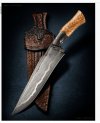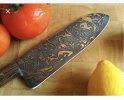
You are using an out of date browser. It may not display this or other websites correctly.
You should upgrade or use an alternative browser.
You should upgrade or use an alternative browser.
Photos Copper strip on blade
- Thread starter Ptrkgrgr
- Start date
Hengelo_77
Basic Member
- Joined
- Mar 2, 2006
- Messages
- 5,967
It's a layer of Cu between layers of steel
It is forged
It is forged
Since the forge welding temp is up around 2100F to 2200F, and copper melts <2,000F how do you keep the copper from being molten and running out from between layers of steel?It's a layer of Cu between layers of steel
It is forged
- Joined
- Dec 30, 2018
- Messages
- 267
Since the forge welding temp is up around 2100F to 2200F, and copper melts <2,000F how do you keep the copper from being molten and running out from between layers of steel?
you can forge weld at 1700-1800 degrees (even colder with a big enough press). There a good number of copper San Mai billets out there
Stacy E. Apelt - Bladesmith
ilmarinen - MODERATOR
Moderator
Knifemaker / Craftsman / Service Provider
- Joined
- Aug 20, 2004
- Messages
- 36,504
Peter ( I'm guessing that is your name from ptrkgrgr),
A description of exactly what you want and a sketch/drawing would help us a lot.
Also, filling out your profile with your location would help.
A description of exactly what you want and a sketch/drawing would help us a lot.
Also, filling out your profile with your location would help.
I had no idea copper could be forged welded with steel, but I'm no expert at forge welding at all. I've used nickel strips between layers of San Mai and Damascus, but the melting point of nickel is over 2600°F so that's pretty easy.you can forge weld at 1700-1800 degrees (even colder with a big enough press). There a good number of copper San Mai billets out there
I'd LOVE to forge weld some copper between layers of San Mai. That would look so good. If anybody can provide guidance on how to do it I'd love to try it.
- Joined
- Sep 21, 2014
- Messages
- 2,828
I'd LOVE to forge weld some copper between layers of San Mai. That would look so good. If anybody can provide guidance on how to do it I'd love to try it.
I hope others with more experience will chime in, especially if I'm wrong...
I've never done copper, but I have made up a 1080/15N20 damascus billet at ~ 1850F. The best guidance I have is to get the surfaces as flat as possible and make sure they are clean. I also used a 25-ton press for most of the heats and forging. I'm not sure I would try this by hand.
If you have any experience with machinist tools, this is why there is oiled paper wrapped around the surfaces. They are machined so flat, that if clean, they will diffusion weld themselves together with on piece sitting on top of another.
I'm also wondering how much forging the copper can take, so I'd guess these were welded up as bar stock then stock removal from there. I can't imagine forging a blade with the copper in it.
Stacy E. Apelt - Bladesmith
ilmarinen - MODERATOR
Moderator
Knifemaker / Craftsman / Service Provider
- Joined
- Aug 20, 2004
- Messages
- 36,504
One thing that people forget is that a melting point given in a book is at STP. If you add energy in any form you do the same as increasing the temperature. forging bending, pressing are all energies that will change the melting point.Hit a barely glowing bar of steel wirt-th a forging hammer and it will glow much brighter at the spot hit. Put a 1600°F piece of copper under a 20 ton press and it will melt/smush right out of the dies. Forge a piece of very expensive mokume san-mai a tad too hot and hit it too hard and liquid copper/brass will squirt out of the layers. Don't ask me why I know the last factoid.
Another factor is that copper does not forge well hot. It forges fine annealed and between 200° and 1000°. Above that it tends to smush and crumble.
Another factor is that copper does not forge well hot. It forges fine annealed and between 200° and 1000°. Above that it tends to smush and crumble.
In the case of the dion Damascus stuff they use a special process to weld that things together with thqt i believe is a type of defusion welding. Some people run the billets flat and this leaves some of the lines straight but they are often heated and forged so you get that more organic look. Im not sure what precautions are needed to keep from melting the copper all the way.
Stacy E. Apelt - Bladesmith
ilmarinen - MODERATOR
Moderator
Knifemaker / Craftsman / Service Provider
- Joined
- Aug 20, 2004
- Messages
- 36,504
Diffusion welding is a very different thing.
- Joined
- Dec 24, 2016
- Messages
- 3,373
I’ll take a shot. I’d love to see the image you are trying to post to get a better idea of what you are trying to achieve.
Sounds like you want to copper wash the nickel strip in the middle of a go Mai blade. I believe that’s done by a having a stack of say 1080/15n20/1080/15n20/1080 which should standard etch in diluted ferric Dark/Shinny/Dark per side when finished. Then you take another batch of diluted ferric with Copper soaking in it and etch your blade once again. The copper in the ferric should wash over the nickel layer. Leaving you with Dark/Copper/Dark per side.
I cannot find the images I’ve seen of this right now. Imagine the top knife with a copper stripe where the nickel is. The Damascus is a better example but a little busy compared to a go Mai blade.
Hope this helps, I’ve never done this before but I believe we are on the same page. I’ve seen pics out there and I like the look.


Sounds like you want to copper wash the nickel strip in the middle of a go Mai blade. I believe that’s done by a having a stack of say 1080/15n20/1080/15n20/1080 which should standard etch in diluted ferric Dark/Shinny/Dark per side when finished. Then you take another batch of diluted ferric with Copper soaking in it and etch your blade once again. The copper in the ferric should wash over the nickel layer. Leaving you with Dark/Copper/Dark per side.
I cannot find the images I’ve seen of this right now. Imagine the top knife with a copper stripe where the nickel is. The Damascus is a better example but a little busy compared to a go Mai blade.
Hope this helps, I’ve never done this before but I believe we are on the same page. I’ve seen pics out there and I like the look.


Richard338
Gold Member
- Joined
- May 3, 2005
- Messages
- 6,423
I picked up this little knife from Charles Roddenberry a couple of years ago.
He makes a variety of interesting san mai type materials. I haven't seen him on BF in some time, but you can find examples on Instagram.

He makes a variety of interesting san mai type materials. I haven't seen him on BF in some time, but you can find examples on Instagram.

This is what I am talking about

 . This is how they say they do it "
. This is how they say they do it "
William Engineering LLC is a commercial developer of clad metals used for cutting tools and knives.
William has used its 50 plus years of metal joining knowledge to patent the process of bonding high speed steels. High speed steels are tool steels with added tungsten, molybdenum, vanadium and chromium which are able to form carbides allowing for high wear resistance. William uses a solid phase bonding (SPB) process that joins the metal at an atomic level. No brazing or other filler compounds are used.
SPB allows for exotic high performance alloys to be located at the cutting edge of the tool or knife while the bulk of the cutting tool uses more economical or aesthetically pleasing materials. It eliminates the compromise many designers encounter when choosing mono-metals for cutting application.
Dion Damascus was developed by William Engineering using SPB to provide knife makers with a pattern steel ready to be forged or ground into a blade. We've removed the labor intensive task of layering materials. Dion Damascus is a blank canvas and is ready for you to add your own patterns by forging drilling, grinding and punching." @
https://diondamascus.com
I'm not sure if this is what the op is talking about but I have been seeing a fair bit of it lately.


William Engineering LLC is a commercial developer of clad metals used for cutting tools and knives.
William has used its 50 plus years of metal joining knowledge to patent the process of bonding high speed steels. High speed steels are tool steels with added tungsten, molybdenum, vanadium and chromium which are able to form carbides allowing for high wear resistance. William uses a solid phase bonding (SPB) process that joins the metal at an atomic level. No brazing or other filler compounds are used.
SPB allows for exotic high performance alloys to be located at the cutting edge of the tool or knife while the bulk of the cutting tool uses more economical or aesthetically pleasing materials. It eliminates the compromise many designers encounter when choosing mono-metals for cutting application.
Dion Damascus was developed by William Engineering using SPB to provide knife makers with a pattern steel ready to be forged or ground into a blade. We've removed the labor intensive task of layering materials. Dion Damascus is a blank canvas and is ready for you to add your own patterns by forging drilling, grinding and punching." @
https://diondamascus.com
I'm not sure if this is what the op is talking about but I have been seeing a fair bit of it lately.
The top one is a fighter with wrought iron welded to the blade using nickle foil and is more like the example i showed and the bottom is the copper wash that has been mentioned.I’ll take a shot. I’d love to see the image you are trying to post to get a better idea of what you are trying to achieve.
Sounds like you want to copper wash the nickel strip in the middle of a go Mai blade. I believe that’s done by a having a stack of say 1080/15n20/1080/15n20/1080 which should standard etch in diluted ferric Dark/Shinny/Dark per side when finished. Then you take another batch of diluted ferric with Copper soaking in it and etch your blade once again. The copper in the ferric should wash over the nickel layer. Leaving you with Dark/Copper/Dark per side.
I cannot find the images I’ve seen of this right now. Imagine the top knife with a copper stripe where the nickel is. The Damascus is a better example but a little busy compared to a go Mai blade.
Hope this helps, I’ve never done this before but I believe we are on the same page. I’ve seen pics out there and I like the look.
View attachment 1403857
View attachment 1403856

